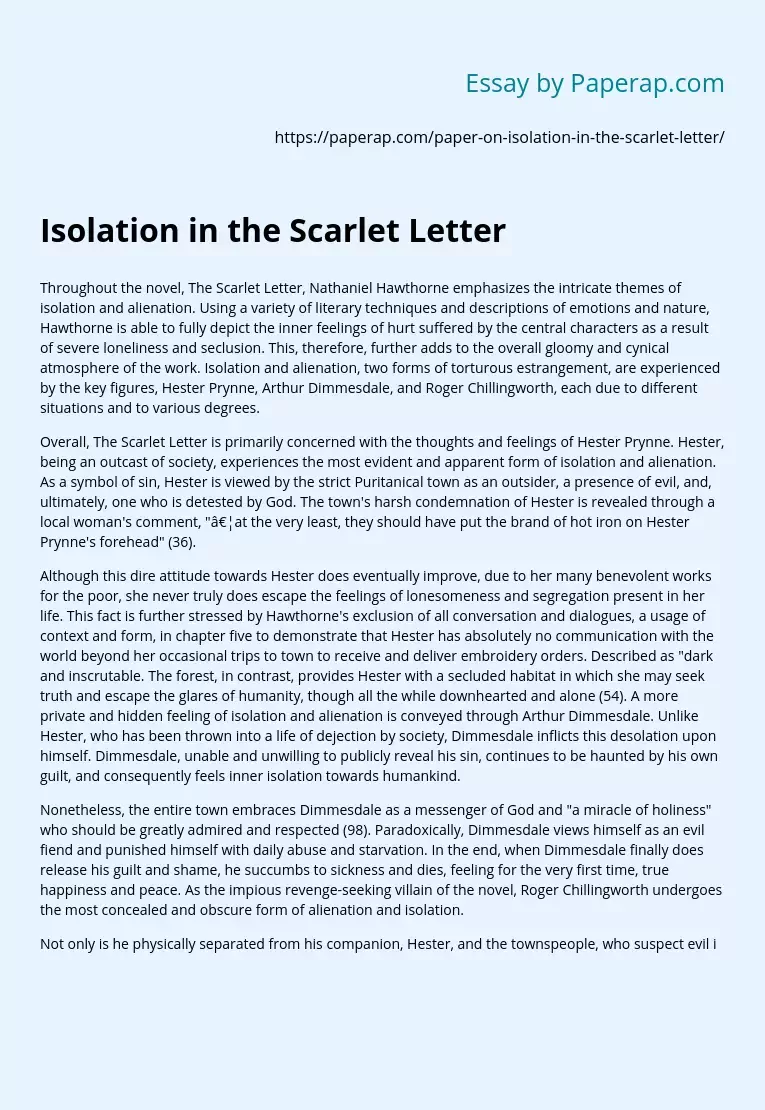Isolation in the Scarlet Letter
Throughout the novel, The Scarlet Letter, Nathaniel Hawthorne emphasizes the intricate themes of isolation and alienation. Using a variety of literary techniques and descriptions of emotions and nature, Hawthorne is able to fully depict the inner feelings of hurt suffered by the central characters as a result of severe loneliness and seclusion. This, therefore, further adds to the overall gloomy and cynical atmosphere of the work. Isolation and alienation, two forms of torturous estrangement, are experienced by the key figures, Hester Prynne, Arthur Dimmesdale, and Roger Chillingworth, each due to different situations and to various degrees.
Overall, The Scarlet Letter is primarily concerned with the thoughts and feelings of Hester Prynne. Hester, being an outcast of society, experiences the most evident and apparent form of isolation and alienation. As a symbol of sin, Hester is viewed by the strict Puritanical town as an outsider, a presence of evil, and, ultimately, one who is detested by God. The town’s harsh condemnation of Hester is revealed through a local woman’s comment, “…at the very least, they should have put the brand of hot iron on Hester Prynne’s forehead” (36).
Although this dire attitude towards Hester does eventually improve, due to her many benevolent works for the poor, she never truly does escape the feelings of lonesomeness and segregation present in her life. This fact is further stressed by Hawthorne’s exclusion of all conversation and dialogues, a usage of context and form, in chapter five to demonstrate that Hester has absolutely no communication with the world beyond her occasional trips to town to receive and deliver embroidery orders.
Described as “dark and inscrutable. The forest, in contrast, provides Hester with a secluded habitat in which she may seek truth and escape the glares of humanity, though all the while downhearted and alone (54). A more private and hidden feeling of isolation and alienation is conveyed through Arthur Dimmesdale. Unlike Hester, who has been thrown into a life of dejection by society, Dimmesdale inflicts this desolation upon himself. Dimmesdale, unable and unwilling to publicly reveal his sin, continues to be haunted by his own guilt, and consequently feels inner isolation towards humankind.
Nonetheless, the entire town embraces Dimmesdale as a messenger of God and “a miracle of holiness” who should be greatly admired and respected (98). Paradoxically, Dimmesdale views himself as an evil fiend and punished himself with daily abuse and starvation. In the end, when Dimmesdale finally does release his guilt and shame, he succumbs to sickness and dies, feeling for the very first time, true happiness and peace. As the impious revenge-seeking villain of the novel, Roger Chillingworth undergoes the most concealed and obscure form of alienation and isolation.
Not only is he physically separated from his companion, Hester, and the townspeople, who suspect evil intervention, but is also mentally detached from himself. To exhibit this transformation, Hawthorne expresses the character of Roger Chillingworth primarily through private contemplation; Chillingworth exposes his true self only through his thoughts. With exception to Hester, Chillingworth speaks to no other person about his plans or motives. Following his vow to uncover Hester’s secret lover, Chillingworth slowly begins to lose his true identity to the devil.
Such pure wickedness causes Chillingworth to eventually withdraw from his prior life and isolate himself to live in a world, which through his eyes, only contains bitterness and hate. Although Hester, Dimmesdale, and Chillingworth all experience alienation and isolation, each endures a different aspect and to various extents. Hester is alienated from her fellow man and is completely cut off from a life of customariness and normality. On the other hand, Dimmesdale, essentially the town’s public figure, feels alone in the fact that he is the sole person, besides Hester, to really understand the true man within himself.
This agonizing wound is so strong that it eventually takes his life. However, Chillingworth is the character that goes through the most harsh and excruciating form of torture. To surrender to evil and watch oneself gradually wither away due to one’s own choice is one of the most unbearable pains known to man. Revealing the sinister sides of humanity, The Scarlet Letter expresses the torment and anguish that humanity sets upon each other through hypocritical laws and its rejection of love and passion in favor of principles and morality.
The agony of isolation and alienation that Hester and Dimmesdale go through, which directly extends to Chillingworth’s distress, is caused by the firm belief, by the town, that they are responsible for the extermination of all existing sin on earthy, though they themselves sin. IN addition, Hawthorne explains that society, in judging people according to what they themselves believe to be proper and ethical is, appallingly to claim to be flawless and equal to the superiority of God himself. This moral dilemma further points out the dishonesty of humankind and, above all, its inability to be true.
Isolation in the Scarlet Letter. (2018, Nov 23). Retrieved from https://paperap.com/paper-on-isolation-in-the-scarlet-letter/

